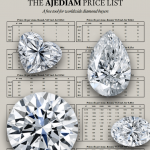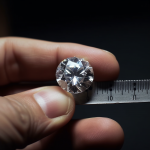Diamond Prices
Read moreThe Kazanjian Red Diamond
A Rarity Among The Rarest Of Diamonds
Diamonds come in a variety of sizes, shapes, and colors, just as the stories behind them do. However, red diamonds are the rarest. Less than 30 of them have ever been found, and only three of them weigh more than 5 carats. With its 5.05 carat weight, the Kazanjian Red Diamond is the second largest red diamond ever found. The rarity of its color is matched only by its extraordinary story. What is now estimated to be worth over 50 million dollars, was once bought for a humble 280 British pounds. Learn how this rare diamond made its way across four continents and many owners, including Hitler himself.
In this article:

- Discovered in
- 1926 or 1927
- Country of Origin
- South Africa
- Mine of Origin
- Lichtenberg, Western Transvaal region
- Carat weight
- 5.05 carats
- Cut Shape
- Emerald-cut
- Clarity
- Exact clarity grade is not specified, but reported to be exceptionally clear and intensely colored.
- Color
- Deep red, evoking love, strength, energy, and passion. Often compared to a drop of blood, particularly under candlelight.
- Previous Owners
- Goudvis Brothers
- Nazis (confiscated during World War II)
- George Prince
- Ernest Oppenheimer
- Royal Asscher company
- Anonymous private collector (1970s)
- Current Owner
- Kazanjian company (since 2007)
- Estimated Value
- unknown
The origins of the Kazanjian Red Diamond
Some diamonds are deemed to be of great value from the moment of their discovery. For this reason, a diamond digger may see his life changed in the blink of an eye. However, this was not the case for the Kazanjian Red Diamond. Little is known about its precise origin or even the time of its discovery. This is due to the fact that in its original shape, it was a 35-carat lump of ‘bort’. In the diamond industry, this is what they call non-gem-quality diamonds.
From a lump of Bort to Kazanjian Red Diamond
The lump of bort was mined in Lichtenberg, the Western Transvaal region of South Africa either in 1926 or 1927. The 1920s were a period of a huge diamond rush in South Africa, as many great diamonds were discovered at that time and even greater diamonds were rejected because they were colored. Nowadays, fancy colored diamonds are considered the ultimate investments, yet back then they were merely a curiosity that was worth nothing.
This fateful piece of boart could have been easily overlooked and destined as another piece to supply the needs of other rising industries at the time… Thankfully, it was acquired by an unnamed representative of the Goudvis Brothers company. Although we do not know the buyer’s name, we do know that he engaged in a risky investment. Moreover, we also know that at least, in this case, his intuition was right because the odds were that the lump of bort would be worthless. However, he took a chance; paid 280 pounds or 8 pounds per carat, and sent the stone to the company’s headquarters in Amsterdam.
The Cutting of the Kazanjian Red Diamond
The diamond sparked controversy
As the lump of boart arrived in the office of the Goudvis Brothers, it sparked a huge argument between the brothers. The younger saw it as a waste of time and resources. Had he had his way, the diamond’s story would end there. Yet, the older, more experienced, brother persisted and called the company’s master cutter.
What followed was a cutting process of seven months, where the lump was studied, and carefully stripped of its low-quality layers. It gradually changed its color to brown, then orange, and finally blood-red. The original 35ct lump had been stripped of 85% of its mass until only perfection had remained. The final product of the cutting was an intensely red emerald-cut diamond, weighing 1.01 grams or 5.05 carats.
The modern ownership history of the Kazanjian Red Diamond
The Goudvis Brothers became the first discoverers, cutters, and owners of the Kazanjian Red Diamond. The enterprise looked like it would pay off better than any of them had hoped to imagine. However, finding a buyer for the Red Diamond would prove to be much more difficult. Being such a rarity, it was often misidentified by buyers, who confused the diamond for a ruby stone, which greatly lowered the stone’s allure as a potential investment.
A great deal was turned down
The Goudvis Brothers sent the stone to New York in search of buyers on two separate occasions. No serious inquiries were made during the stone’s first visit to the big apple. However, Tiffany made a serious offer the second time around. The renowned house offered 100.000 USD, but the Goudvis Brothers demanded 150.000 for it, leading to a definitive impasse. This was a decision that the Goudvis Brothers would soon regret.
The red diamond was confiscated by the Nazis
In 1941, in the midst of the Second World War, the Netherlands was invaded by Nazi Germany. During the occupation, it is well known the country was stripped of some of its most valuable possessions. The number of goods confiscated was indeed vast. Gold, silver, paintings, books, and religious treasures, often of great cultural significance, were stripped from the land. For our purposes, it is key to mention the seizures included gemstones and jewelry. Most notably, the Red Diamond, which had been kept safe in a vault in Arnheim, was confiscated by the Nazis in 1944.
The blood-red gemstone was moved to a salt mine in Berchtesgaden, a mine close to Hitler’s Bavarian summer retreat that was used as a storage space for all kinds of war loot. The treasure hoard included a vast collection of rare diamonds. Shortly after the war’s end, Allied troops found the hidden treasures of Berchtesgaden.
The war-loot commission returned the diamond to the Goudvis Brothers
After a bloody campaign, General McNarney reported his findings to the war-loot commission. The acclaimed military leader stated that a large collection of diamonds plus a ruby had been found as a consequence of their operation. The head of the war loot commission was Louis Asscher, an experienced diamond trader who was part of the Royal Asscher Diamond Company. The specialist inspected the gemstone and immediately knew it wasn’t a ruby. It could be then said that lady luck was clearly invested in the Goudvis’ story. The gemstone turned out to be the seized diamond of the Goudvis Brothers. Upon his discovery, Asscher returned the gem to its rightful owners.
The Goudvis brothers sold the Red Diamond out of necessity
The Second World War devastated the Netherlands and its diamond industry in particular. Once, the diamond capital of the world, Amsterdam was now a shadow of its former self. Indeed, survival in war-torn Amsterdam was no easy task, for which the Goudvis Brothers had amassed a massive debt. They couldn’t keep their beloved red diamond and were forced to sell it. The piece was purchased by the broker George Prince for only 57000 guilders, which in the post-war period amounted to 21450 dollars, a figure five times lower than what Tiffany had once offered.
The Red Diamond disappears in private collections
George Prince sold the diamond to the famous diamond entrepreneur and philanthropist Ernest Oppenheimer. Oppenheimer’s De Beers company later sold the gem to the Royal Asscher company. Asscher kept it for an unknown amount of time, before selling it to an anonymous private collector in the 1970s. Following this sale, the red diamond disappeared from public view for nearly 37 years.
The Red Diamond becomes the Kazanjian Diamond
In 2007 the diamond resurfaced and landed on Douglas Kazanjian’s desk. After thorough research, he became sure that he had re-discovered the long-lost Goudvis Brothers’ red diamond. Kazanjian then purchased the diamond for an undisclosed amount from a woman from East Asia and renamed it the ‘Kazanjian Red Diamond’. Douglas humorously bestowed the stone with the new name in order to honor the legacy of his family’s ruby trading tradition.
Since then, the diamond remains in the Kazanjian company’s possession. It has been paraded around the world since 2007 with the profits from each of the stone’s appearances mainly going towards charitable foundations. Truly, a noble purpose for the Kazanjian gem.
The characteristics of the Kazanjian Red Diamond
Weighing 5.05 carats or 1.010 grams; With a deep red color, evoking love, strength, energy, and passion upon its observer, the stone has been often compared to a drop of blood, particularly if viewed under candlelight.
The diamond is exceptionally clear and intensely colored
Although the diamond has been reported to be of exceptional clarity, and certainly, a fancy colored diamond by the GIA, its exact clarity grade is not known. Fancy-colored diamonds are extremely rare, with only one out of ten thousand possessing a natural color. The strength of their color is the deciding factor in determining their value.
The significance of the Kazanjian Red Diamond
The Kazanjian diamond is so rare, it’s impossible to put a price on it
When the diamond was cut in the late 1920s, it was the largest red diamond in the world, however, the Moussaieff Red Diamond, displaced this article’s star in 1990, with a minuscule difference of 0.6 carats. Only three red diamonds in the world are known to weigh over 5 carats and only about 30 red diamonds have ever been found in history.
The Kazanjian Red Diamond’s place among the elite of the rarest type of diamonds makes its value extremely difficult to measure. It is simply incomparable to almost anything else in the world. This means that it is entirely dependent on what someone is willing to pay for it. For comparison, a three-carat red diamond was sold for about 25 million. Following the same logic, the Kazanjian Red diamond could be priced at over 50 million dollars. This would amount to a whopping 10 million dollars per carat. The original amount paid for it was 280 pounds which in today’s money would amount to 17400 dollars or about 3400 dollars per carat.
We hope you enjoyed the read!
If you’d like to read about other famous diamonds like the Orlov, Eureka, or Premier Rose diamonds, you can visit Ajediam’s Famous Diamonds glossary. Or, if you’re feeling inspired, you can browse Ajediam’s premium diamond collections shop.



